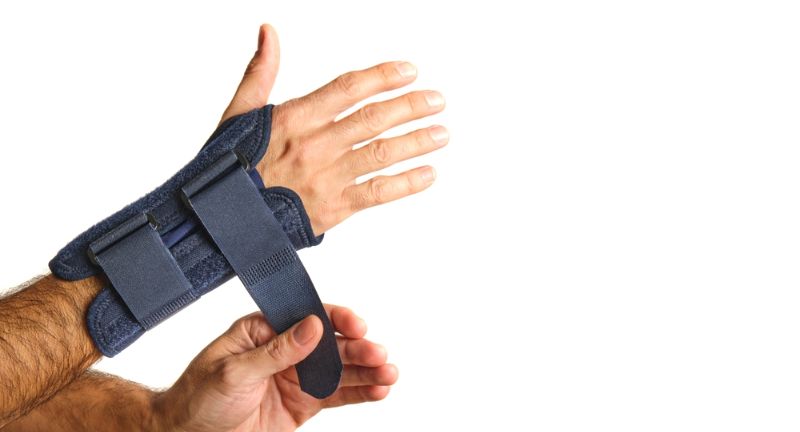HEALTH + FITNESS
20 Ways to Get Relief From Psoriatic Arthritis Pain
Published
2 weeks agoon

Shutterstock
Psoriatic arthritis is a complex autoimmune condition that causes joint pain, stiffness, and swelling. Managing this condition involves a multifaceted approach that combines medication, lifestyle adjustments, and alternative therapies. From physical activities designed to strengthen and protect joints to dietary changes that help reduce inflammation, each strategy plays a critical role. Moreover, psychological support and regular medical supervision are essential to navigate the emotional and physical challenges of the disease. Understanding and implementing various pain management techniques can significantly enhance the quality of life for those affected by psoriatic arthritis.
Anti-Inflammatory Medications

Shutterstock
Nonsteroidal anti-inflammatory drugs (NSAIDs), such as ibuprofen or naproxen, are commonly used to manage psoriatic arthritis pain by reducing inflammation. These medications are available over-the-counter and can provide temporary relief from joint pain and swelling. It’s important to consult with a healthcare professional before starting any new medication to ensure it’s safe and appropriate for your condition. Prolonged use of NSAIDs can have side effects, so they should be used judiciously and under medical supervision.
Prescription Medications

Shutterstock
For more severe cases of psoriatic arthritis, doctors may prescribe stronger medications such as disease-modifying antirheumatic drugs (DMARDs) or biologics. These drugs work by targeting specific parts of the immune system that fuel inflammation and joint damage. Biologics, in particular, are designed to block certain proteins that play a key role in inflammatory processes. Regular monitoring by a healthcare provider is crucial, as these medications can have significant side effects and require careful management.
Physical Therapy

Shutterstock
Engaging in physical therapy can provide significant benefits for those with psoriatic arthritis. A physical therapist can develop a personalized exercise program that strengthens the muscles around the joints, improves flexibility, and reduces overall pain. These exercises help to stabilize affected joints and prevent further joint damage. Regular physical therapy sessions can also teach patients how to protect their joints during daily activities.
Regular Exercise

Shutterstock
Maintaining regular physical activity is crucial for managing psoriatic arthritis. Low-impact exercises such as walking, swimming, or cycling can keep joints flexible and improve overall health. Exercise not only helps in maintaining mobility but also aids in weight management, which is important in reducing the strain on joints. It’s important to choose activities that do not exacerbate joint pain, and always warm up and cool down to avoid injury.
Heat and Cold Therapies

Shutterstock
Applying heat or cold to affected areas can be an effective way to reduce psoriatic arthritis pain. Heat therapy, such as using a warm towel or a heating pad, can relax tense muscles and improve blood flow to stiff joints. Cold therapy, like applying ice packs to inflamed joints, can help reduce swelling and numb areas of intense pain. It’s beneficial to alternate between heat and cold therapies to find the best approach for your symptoms.
Weight Management

Shutterstock
Keeping a healthy weight is vital in managing psoriatic arthritis. Excess body weight puts additional pressure on your joints, particularly those that bear weight such as the hips, knees, and ankles. Managing your weight can help lessen the severity of symptoms and reduce the overall stress on your joints. A combination of diet and exercise is the best strategy for maintaining a healthy weight.
Joint Protection Techniques

Shutterstock
Using joint protection techniques can alleviate the stress on inflamed joints. Tools such as splints or braces provide support and can prevent further damage during daily activities. These devices also help in maintaining proper joint alignment and reducing pain. It’s important to consult with a healthcare professional about the best protective devices for your specific needs.
Stress Management

Shutterstock
Stress can exacerbate the symptoms of psoriatic arthritis. Techniques such as meditation, yoga, or deep breathing exercises can help manage stress effectively. Reducing stress not only diminishes the likelihood of flare-ups but also improves overall mental health. It’s beneficial to incorporate these practices into your daily routine to maintain a lower stress level.
Adequate Sleep

Shutterstock
Good sleep is crucial for managing pain in psoriatic arthritis. Adequate sleep helps the body to repair itself and manage pain more effectively. Lack of sleep can increase pain sensitivity and contribute to fatigue, which can worsen arthritis symptoms. It’s important to establish a regular sleep schedule and create a restful environment to promote better sleep.
Healthy Diet

Shutterstock
A balanced diet rich in anti-inflammatory foods can significantly impact the management of psoriatic arthritis. Foods high in omega-3 fatty acids, such as salmon and flaxseeds, are known to reduce inflammation. Fruits, vegetables, and whole grains also contribute to a healthy diet and can help reduce joint swelling and pain. Avoiding processed foods and excessive sugar can further help in reducing flare-ups.
Avoid Smoking and Limit Alcohol

Shutterstock
Smoking and excessive alcohol consumption can aggravate psoriatic arthritis symptoms. Smoking is particularly harmful as it can increase inflammation and reduce the effectiveness of medications. Moderating alcohol intake is also important as it can impact liver function and interact with medications. Quitting smoking and limiting alcohol can markedly improve symptom management and overall health.
Topical Treatments

Shutterstock
Topical treatments can provide localized relief from psoriatic arthritis pain. Creams and ointments containing capsaicin or NSAIDs can be applied directly to the skin over painful joints. These treatments work by reducing inflammation at the site and can be used in conjunction with oral medications. It’s important to use these products as directed and discuss them with your doctor, especially if you have sensitive skin.
Acupuncture

Shutterstock
Acupuncture is an alternative therapy that some people with psoriatic arthritis find helpful. It involves inserting thin needles into specific points on the body to relieve pain. The therapy is thought to stimulate the body’s natural pain-relieving compounds. Acupuncture should be performed by a licensed practitioner to ensure safety and effectiveness.
Massage Therapy

Shutterstock
Massage therapy can be a great way to reduce stress and relieve muscle tension associated with psoriatic arthritis. A professional massage can improve circulation, which helps reduce joint stiffness and pain. It is also a relaxing activity that can significantly lower stress levels, potentially reducing flare-ups. When opting for massage therapy, it’s crucial to work with a therapist who is experienced with arthritis patients.
Mind-Body Practices

Shutterstock
Mind-body practices such as tai chi or qigong blend physical movements with meditation and breath control, offering dual benefits for those with psoriatic arthritis. These practices help in maintaining joint flexibility and muscular strength. They also promote mental well-being, helping to manage the emotional challenges of living with a chronic condition. Engaging in these activities can improve both physical health and psychological resilience.
Supplements

Shutterstock
Some dietary supplements may help alleviate joint pain associated with psoriatic arthritis. Turmeric, glucosamine, and chondroitin are among the supplements believed to reduce inflammation and support joint health. It’s essential to consult with a healthcare provider before starting any supplements to ensure they won’t interfere with your medications or health conditions. Always choose high-quality supplements and be cautious of potential side effects.
Epsom Salt Baths

Shutterstock
Taking baths with Epsom salts can help soothe sore joints and relax muscles. The magnesium in Epsom salts is absorbed through the skin and can help to reduce inflammation. A warm bath can also be a calming activity that reduces stress, which is beneficial for managing chronic conditions. It’s a simple, enjoyable way to provide relief from arthritis pain at home.
Ergonomic Tools

Shutterstock
Utilizing ergonomic tools can significantly reduce the strain on joints during everyday activities. These tools are designed to maximize efficiency and minimize discomfort in the workplace and at home. Examples include ergonomic keyboards, comfortable seating, and tools with easy-grip handles. Such adjustments can make daily tasks less painful and more manageable for individuals with psoriatic arthritis.
Education and Support

Shutterstock
Gaining a better understanding of psoriatic arthritis and connecting with others who share the condition can be incredibly helpful. Educational resources and support groups provide valuable information on managing symptoms and new treatments. Sharing experiences and tips with others who understand what you’re going through can also provide emotional support. These resources can empower patients to take an active role in their treatment and overall health management.
Regular Medical Checkups

Shutterstock
Regular visits to a rheumatologist are crucial for those with psoriatic arthritis. These checkups allow doctors to monitor the disease’s progression and adjust treatments as necessary. Early detection of changes in symptoms can lead to more effective management of the condition. Maintaining an ongoing dialogue with your healthcare provider ensures the best possible outcomes and helps in making informed decisions about your health care.
Conclusion

Shutterstock
Living with psoriatic arthritis requires a proactive approach to manage symptoms and maintain a healthy lifestyle. By incorporating a variety of pain management techniques, individuals can find meaningful relief and improve their daily functioning. It is crucial to work closely with healthcare professionals to tailor treatments to individual needs and adjust strategies as the condition evolves. Support from family, friends, and fellow sufferers can also provide a much-needed emotional boost. Ultimately, with the right combination of treatments, lifestyle changes, and support, managing psoriatic arthritis becomes a more achievable goal.
ADVERTISEMENT - CONTINUE BELOW
Related Topics:

About Lifestylogy
Lifestylogy provides our community with the latest trending health, fitness and wellness news from around the world. Our expert lifestyle team explores ways to promote positive stories, photos and videos. We are inspired to share our incredible insight and motivation with all lifestyle enthusiants to help live your life to the fullest.
More From Lifestylogy
-


Ireland Baldwin Celebrates Eating Disorder Recovery Milestone
-


Olivia Newton-John Postpones Concert amid Cancer Diagnosis
-


Savannah Guthrie to Co-Anchor ‘Today’ Show From Home
-


RHOC Star’s Shocking Keto Weight Loss
-


Kelly Clarkson Reveals Unhappiness Led to Losing Weight
-


Over 40? These Exercises are a Must
-


No Time to Workout? Try Hilaria Baldwin’s One-Minute Ab Workout
-


New Study Says These Foods May Increase Risk of Breast…
-


Kendall Jenner Reveals Personal Struggle With Anxiety
ADVERTISEMENT
ADVERTISEMENT


HUMAN INTEREST / VIRALMay
Unveiling of 24/7 Portal, NYC to Dublin on 5/8/24. THE PORTAL: a visual bridge connecting New York City to Dublin Manhattan.


CELEBRITYMay
Taylor Swift Sings Surprise Mashup of Begin Again & Paris At Eras Tour Date With Travis Kelce In Attendance (5/12/24)


ANIMALSMay
AZ – Woman Removes Snake from Wedding, Why isn’t that girl scared of anything? Florence, AZ, 5/5/24.


CELEBRITYMay